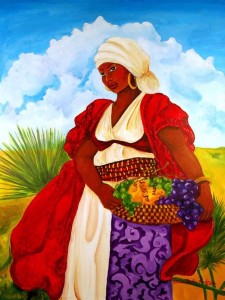
The Gullah people have been able to preserve much of their African cultural heritage because of geography, climate, and patterns of importation of enslaved Africans. Taken from the Western region of Africa in primarily the Krio and Mende populations of what is today Sierra Leone as slaves and transported to some areas of Brazil (including Bahia), the Gullah-Gheechee slaves were sold to slave owners in what was then Charlestowne, South Carolina. According to British historian P.E.H. Hair, Gullah culture was formed as a creole culture in the colonies and United States from elements of many different African cultures who came together there. These included the Wolof, Mandinka,Fula, Baga, Susu, Limba, Temne, Mende, Vai, Kissi, Kpelle, etc. of the Rice Coast, and many from the Gold Coast, Calabar, Congo Republic, and Angola.
The Gullah/Geechee Nation
By the middle of the 18th century, thousands of acres in the South Carolina and Georgia Lowcountry and the Sea Islands were developed asrice fields. African farmers from the “Rice Coast” brought the skills for cultivation and tidal irrigation that made rice one of the most successful industries in early America.
The subtropical climate encouraged the spread of malaria and yellow fever, carried by mosquitos. These tropical diseases were endemic in Africa and had been carried by slaves to the colonies. Mosquitoes in the swamps and inundated rice fields of the Low country picked up and spread the diseases to English and European settlers, as well. Malaria and yellow fever soon became endemic in the region.
Because of having acquired some immunity in their homeland, Africans were more resistant to these tropical fevers than the Europeans. As the rice industry was developed, planters continued to import African slaves. By about 1708, South Carolina had a black majority. Coastal Georgia later developed a black majority after rice cultivation expanded there in the mid-18th century. Malaria and yellow fever became endemic. Fearing disease, many white planters left the Low country during the rainy spring and summer months when fevers ran rampant. Others lived mostly in cities such as Charleston.
The planters left their European or African “rice drivers,” or overseers, in charge of the plantations. These had hundreds of laborers, with African traditions reinforced by new imports from the same regions. Over time, the Gullah people developed a creole culture in which elements of African languages, cultures, and community life were preserved to a high degree. Their culture developed in a distinct way, different from that of African-American slaves in states such as Virginia and North Carolina, where slaves lived in smaller groups, and had more sustained and frequent interactions with whites and British American culture.
African influences are found in every aspect of the Gullahs’ traditional way of life:
- The Gullah word guber for peanut derives from the Kikongo and Kimbundu word N’guba.
- Gullah rice dishes called “red rice” and “okra soup” are similar to West African “jollof rice” and “okra soup”. Jollof rice is a style of cooking brought by the Wolof people of West Africa.
- The Gullah version of “gumbo” has its roots in African cooking. “Gumbo” is derived from a word in the Umbundu language of Angola, meaning okra, one of the dish’s main ingredients.
- Gullah rice farmers once made and used mortar and pestles and winnowing fanners similar in style to tools used by West African rice farmers. Wooden mortar and pestle from the rice loft of a South Carolina low country plantation
- Gullah beliefs about “hags” and “haunts” are similar to African beliefs about malevolent ancestors, witches, and “devils” (forest spirits).
- Gullah “root doctors” protect their clients against dangerous spiritual forces by using ritual objects similar to those employed by Africantraditional healers.
- Gullah herbal medicines are similar to traditional African remedies.
- The Gullah “seekin” ritual is similar to coming of age ceremonies in West African secret societies, such as the Poro and Sande.
- The Gullah ring shout is similar to ecstatic religious rituals performed in West and Central Africa.
- Gullah stories about “Bruh Rabbit” are similar to West and Central African trickster tales about the clever and conniving rabbit, spider, and tortoise.
- Gullah spirituals, shouts, and other musical forms employ the “call and response” method commonly used in African music.
- Gullah “sweetgrass baskets” are coil straw baskets made by the descendants of slaves in the South Carolina Lowcountry, and are almost identical to coil baskets made by the Wolof people in Senegal.
- Gullah “strip quilts” mimic the design of cloth woven with the traditional strip loom used throughout West Africa. The famous kente cloth from Ghana and Akwete cloth from Nigeria are woven on the strip loom.
- The folk song Michael Row the Boat Ashore (or Michael Row Your Boat Ashore) comes from the Gullah culture.
- A non-English song of unknown meaning, preserved by a Gullah family, was found in the 1990s to be a Mende funeral song, probably the longest text in an African language to survive enslavement to the present day USA. This research and the resulting reunion between Gullah and Mende communities was recounted in the 1998 documentary The Language You Cry In.

